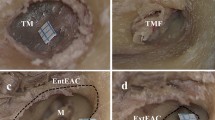Abstract
Introduction
The anatomy of the nerves in the human internal auditory canal (IAC) has been reported by a number of authors, and there are some differences among the viewpoints of the literatures. With the development of the microsurgery and endoscopic surgery in the IAC, the study of the topographical relationship of the nerves in the human IAC becomes more and more important. The purpose of this study was to investigate the anastomosis and topographical relationship of the nerves in the human IAC.
Methods
In this study, we dissected 30 human temporal bones from 15 heads, and examined the topographical relationship and the anastomosis of the nerves in human IAC.
Results
(1) In 11 out of 30 cases (37%), the facial nerve is anterosuperior to the vestibulocochlear nerve through the whole IAC; and for the remaining 19 cases (63%), the facial nerve rotates anteroinferiorly at an angle ranging from 30° to 90°, which is in the same direction as that of the cochlear. (2) Vestibulofacial nerve anastomosis occurs in 25 cases (83%), of which 67% appears near the porus acusticus, and of which 33% appears between the lateral and intermedial portion of IAC. The diameter was about 0.5–1 mm. (3) Vestibulocochlear anastomosis occurs in 24 cases (80%) among which, some brush-like nerve fiber bundles of the cochlear nerve were seen to enter the acculus proprius directly in 13 cases. Transverse vestibulocochlear anastomosis in the fundus of internal acoustic meatus occurred in 15 cases, including two cases with more anastomosis. No vestibulocochlear nerve anastomosis was found in six cases in this study.
Conclusions
Our study shows that the Vestibulofacial nerve anastomosis and the vestibulocochlear nerve anastomosis do exist, and some variations appear due to individual differences. The appearance of the facial and vestibulocochlearnerves is variable but follows certain consistent patterns.

Similar content being viewed by others
References
Arnesen AR (1984) Fiber population of the vestibulocochlear anastomosis in humans. Acta Otolaryngol 98:501–518
Ben N, Itzhak B, Marian K, Karl S, Saul F (2000) Connections of the facial and vestibular nerves: an anatomic study. J Otolaryngol 29:159–161
Cai CP, Sun JZ (1996) Observation of serially sectioned seventh and eighth cranial nerve complex. Chin Arch Otol Head Neck Surg 3:247–250
Chen HX, Yu CT, Zhong SZ (2000) Three-dimensional reconstruction of internal auditory meatus and anatomical study of the inner structures. Chin J Otorhinolaryngol 35:204–206
Fisch U, Esslen E (1972) Total intratemporal exposure of the facial nerve. Pathologic findings in Bell’s palsy. Arch Otolaryngol 95:335–341
Fisch UP (1973) Excision of the Scarpa’s ganglion. Arch Otolaryngol 97:147–149
Gacek RR (2003) Efferent system degeneration in the human temporal bone. Ann Otol Rhinol Laryngol 112:947–54
House WF (1961) Surgical exposure of the internal auditory canal and its contents through the middle cranial fossa. Laryngoscope 71:1363–1385
Hyun SK, Dong I K, Hyuk C (1998) Topographical relationship of the facial and vestibulocochlear nerves in the subarachnoidspace and internal auditory canal. AJNR Am J Neuroradiol 19:1155–1161
Labrousse M, Leve que M, Ouedraogo T (2005) An anatomical study of the vestibulocochlear anastomosis (anastomosis of Oort) in humans: preliminary results. Surg Radiol Anat 27:238–242
Natout MAY, Terr LI, Linthicum FH, House WF (1987) Topography of the vestibulocochlear nerve fibers in the posterior cranial fossa. Laryngoscope 97:954–958
Özdoğmuş Ö, Sezen O, Kubilay U (2004) Connections between the facial, vestibular and cochlear nerve bundles within the internal auditory canal. J Anat 205:65–75
Oort H (1918) Über die verästelung des nervus octavus bei Säugetieren.(Modell des utriculus und sacculus des kaninchens). Anat Anz 51:272–280
Pulec JL (1995) Cochlear nerve section for intractable tinnitus. Ear Nose Throat J 74:468–476
Rasmussen AT (1940) Studies of eighth cranial nerve of man. Laryngoscope 50:67–83
Rubinstein D, Sandberg EJ, Cajade-Law AG (1996) Anatomy of the facial and vestibulocochlear nerves in the internal auditory canal. AJNR Am J Neuroradiol 17:1099–1105
Silverstein H (1984) Cochlear and vestibular gross and histologic anatomy (as seen from postauricular approach). Otolaryngol Head Neck Surg 92:207–221
Author information
Authors and Affiliations
Corresponding author
Rights and permissions
About this article
Cite this article
Tian, Gy., Xu, Dc., Huang, Dl. et al. The topographical relationships and anastomosis of the nerves in the human internal auditory canal. Surg Radiol Anat 30, 243–247 (2008). https://doi.org/10.1007/s00276-008-0311-z
Received:
Accepted:
Published:
Issue Date:
DOI: https://doi.org/10.1007/s00276-008-0311-z




